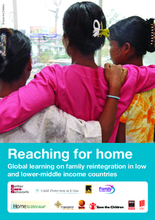This inter-agency, desk-based research aims to arrive at a clearer understanding of reintegration practices for separated children in low and lower-middle income countries. The research pulls together learning from practitioners and academics working with a range of separated children, such as those torn from their families by emergencies, children who have been trafficked or migrated for work, and children living in institutions or on the streets. The report underlines that whilst there is no global definition of the term ‘reintegration’, there is now general agreement that reintegration is a process and not an event, and that it involves more than the simple physical placement of a separated child back within a family. For the purpose of this report reintegration is defined as: The process of a separated child making what is anticipated to be a permanent transition back to his or her immediate or extended family and the community (usually of origin), in order to receive protection and care and to find a sense of belonging and purpose in all spheres of life.
The report examines practice across the different stages of the process – determining suitability for reintegration, preparation, reunification, and post-reunification support – using examples from the field to illustrate the range of activities in place. Of particular note, its section on the preparation process explores the range of transitional alternative care options used by agencies, including drop-in centres, temporary shelters and transit centers, as well as family based placements, with kins or foster carers, highlighting learning from practice.
The paper identifies 11 principles of promising practice for those attempting to ensure the successful reintegration of children. Among others, the need to recognize and respect the range of experiences, needs and situations that separated children face, rather than adopting ‘one size fits all’ approaches to reintegration, including by ensuring the involvement of the child and his/her family in establishing the benchmarks for success and allowing the time and, as far as possible, the resources it takes to achieve them. It also points out that reintegration requires long-term investment, and that is not something that can be offered to children on a temporary basis, as it requires dedication, consistency and quality – all of which require a long-term investment in time, funding, and resources. A particular challenge, as many organisations working in this field are NGOs and thus obtain some of their resources from private sources, working within the constraints set by donors, rather than contributing to the strengthening of national child protection systems.
The report also highlights that there is insufficient documentation to date of reintegration from residential care in low or lower-middle income countries; where it exists, it sheds little light on differences according to age of the child, disability and the context in which it takes place. It concludes by providing a vision of shared learning to guide a stronger and more common approach to supporting the family reintegration of separated children.
©Family for Every Child, the Better Care Network, War Child Holland, the Child Protection in Crisis Network, International Rescue Committee, Save the Children, Retrak, Home: Child Recovery and Reintegration Network, Maestral International.

